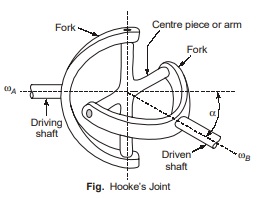Hooke Joint or Universal Coupling
It is a device to connect two shafts whose axes are neither coaxial nor parallel but intersect at a point. This is used to transmit power from the engine to the rear axle of an automobile and similar other applications. It is also known as universal coupling. 
A Hooke’s joint is used to connect two shafts, which are intersecting at a small angle, as shown in Fig. The end of each shaft is forked to U-type and each fork provides two bearings for the arms of a cross. The arms of the cross are perpendicular to each other.
The motion is transmitted from the driving shaft to driven shaft through a cross. The inclination of the two shafts may be constant, but in actual practice it varies, when the motion is transmitted.
Applications :
- Transmission of power from the gear box to the differential or back axle of the automobiles.
- Transmission of power to different spindles of multiple drilling machine.
- Knee joint in milling machine.
The Hooke’s joint as shown in Fig., consists of two forks connected by centre piece, having the shape of a cross or square carrying four trunnions. The ends of the two shafts to be connected together are fitted to the forks.
<< Previous | Next >>
Must Read: What is the Theory of Machines?

